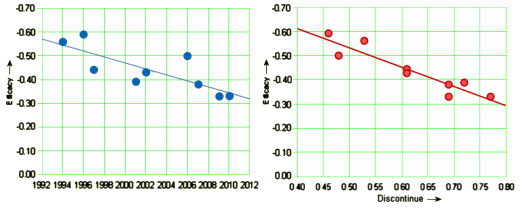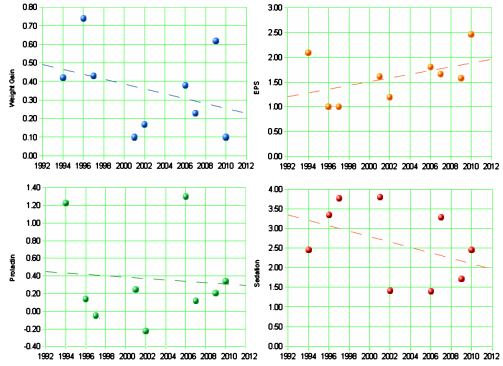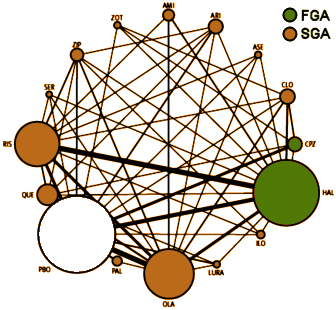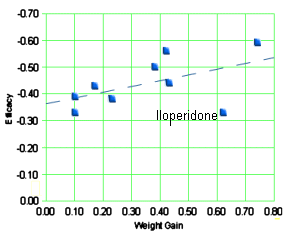I did regressions among the reported means from the Atypical meta-analysis [the mother of meta…] using only the Atypicals approved in the US starting with Risperidal in 1994. The only significant linear regressions I could find with an Open Office Spreadsheet were these two [my cabin didn’t come equipped with SAS]:

The only correlation with Discontinuation Rate was Efficacy, not Adverse Effects. These patients knew when the medication was effective and when it wasn’t. When it wasn’t, they stopped it [as in CATIE]. The Efficacy of subsequent Atypicals actually declined with subsequent releases during the Atypical Era. It’s popular to call the later releases, "me too" drugs. I realize that the goal has been to eliminate the adverse effects, but for what it’s worth – it sure wasn’t improved efficacy. Speaking of adverse effects, they weren’t correlated with Approval Date:

Some of the things we all want to know aren’t in this meta-analysis – Tardive Dyskinesia, Diabetes, Hyperlipidemia. These are all the short-term trials so popular with the clinical research organization set. The authors were all over the hanky-panky, in particular the use of Haldol as the comparator and sole representative of the "first generation" drugs – both the high doses and for the EPS. As someone trained in the "first generation" I rarely used Haldol [this reminds me to talk to the pharmacist about getting some Trilifon].

This diagram shows the various comparators for studies of Efficacy. Haldol was the main FGA and only slightly less common than Placebo. It was all pretty much a trick. These drugs are, indeed, antipsychotics like Thorazine and its first generation friends. I have no complaint that they were approved by the FDA for Psychosis. But their Efficacy was inflated; their toxicity was deflated, their broader non-psychotic use was non-specific, and the deception was industry-wide. As Drs. Tyrer and Kendall pointed out in 2009 [should’ve listened then…]:
The spurious invention of the atypicals can now be regarded as invention only, cleverly manipulated by the drug industry for marketing purposes and only now being exposed.
And here’s one for the road:

While the trend line is not significant, except for the outlier Iloperidone, it’s hard to look at that graph and not see the price of a little Efficacy being a lot of Weight Gain [maybe Metabolic Syndrome?] – much like the price of Efficacy with the FGAs was EPS [maybe TD?].
These articles aren’t easy, but it’s not the authors’ fault, it’s the density of hyperbole and deceit that they’re having to wade through. Their discussion of how they chose their articles alone is a subject for a PhD in something – they eliminated the questionable literature right and left. If you use these medications, this might be one of those articles to buy if you don’t have access. So far, I have hit no red flags…
You would think this study would be headline news in the psychiatry world.
Off topic, but I couldn’t wait to share— this is something I’ve been waiting for for twenty years.
http://www.psmag.com/magazines/pacific-standard-cover-story/joe-henrich-weird-ultimatum-game-shaking-up-psychology-economics-53135/
So much of what our American and Western social scientists think is “human” is cultural and an oddity in the pantheon of what it is to be human. Psychiatry’s KOLs, who are exceptions even within their own culture, are now trying to impose their culturally informed (and unexamined) concepts of “mental illness” and psychoactive drugs on other cultures. This makes our leaders in psychiatry blindly ambitious hegemons who don’t have a deep understanding of what it is to be human and don’t understand themselves in relation to humanity.
There are so many incredible studies where they compare a new atypical neuroleptic to a dose of Haloperidol with lots of dopamine blocking and then find marvellous benefits of their new drug. They improve cognition and negative symptoms, may reduce brain damage, etc. It’s one very plain technique in many of those studies. Another way to see it: it’s a proof that dopamine blocking may cause those things.